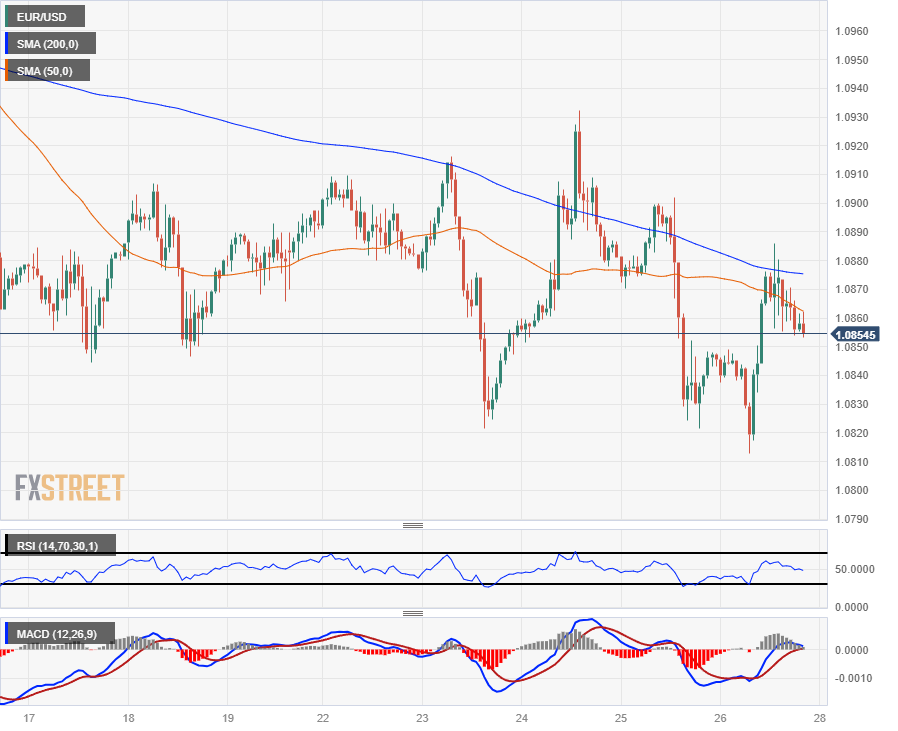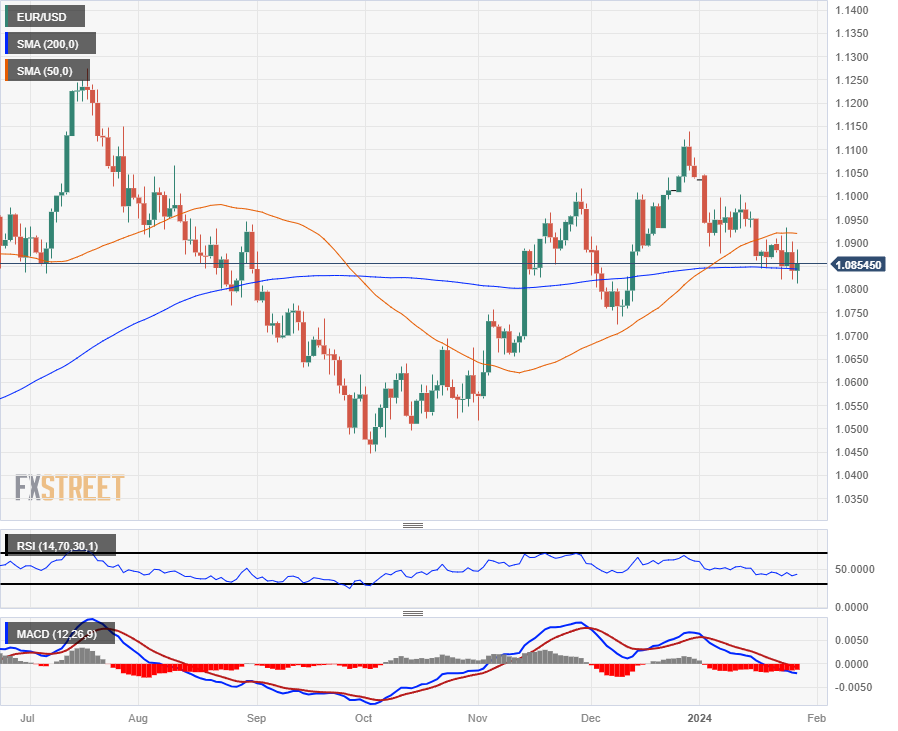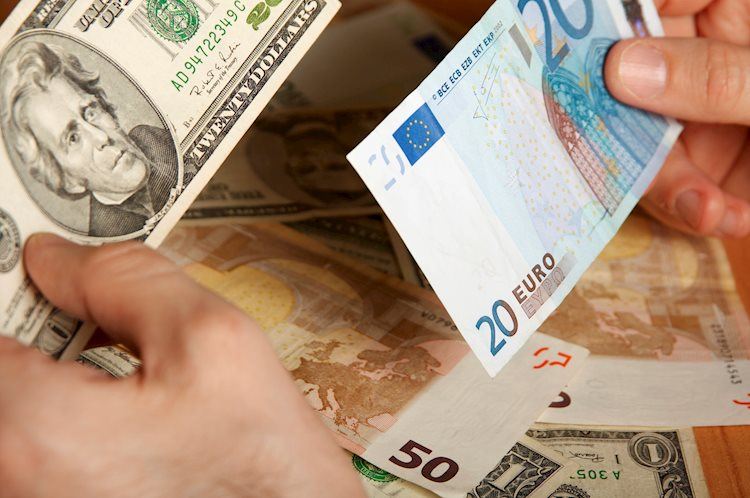- EUR/USD reclaims territory near 1.0880 after drop into 1.0820.
- German Consumer Confidence declined to 11-month low.
- US PCE inflation eased more than expected, but spending remained high.
EUR/USD recovered recent losses on Friday, recovering back into familiar technical levels. Still, overall gains remained limited after German Consumer Confidence backslid to almost a one-year low as economic conditions in Europe remain tepid at best.
US Personal Consumption Expenditure (PCE) Price Index inflation figures eased more than expected, but further gains in December’s Personal Spending alongside an unexpected uptick in Pending Home Sales trimmed rate cut expectations. With the US domestic economy continuing to bump along at a healthy clip, market hopes for early and deep rate cuts from the Federal Reserve continue to wilt.
Daily digest market movers: EUR/USD pares losses despite determined Greenback
- EUR/USD slipped into multi-week lows early Friday after German Gfk Consumer Confidence in February declined to an 11-month low of -29.7 versus the forecasted improvement from -25.1 to -24.5.
- The US Dollar broadly recovered after US YoY Core PCE Price Index figures in December eased to 2.9% from the forecast of 3.0%, previous 3.2%.
- Despite the easing in inflation, US Personal Spending and Pending Home Sales both stepped higher.
- Personal Spending rose 0.7% in December versus the 0.4% forecast, with the previous month’s print getting revised to 0.4% from 0.2%.
- US Pending Home Sales climbed 8.3% in December compared to the expected rebound to 1.5% from the previous month’s 0.3% decline (revised down from 0.0%).
- Next week brings European Gross Domestic Product (GDP) numbers on Tuesday, with the next high-impact rate call from the US Federal Reserve (Fed) slated for Wednesday.
- Euro area Q4 GDP is expected to print at -0.1%, in line with the previous figure as the pan-European economy lags in stagnation.
- Federal Reserve expected to hold rates steady in January, CME FedWatch Tool suggests markets pivoted to betting on the first rate cut in May after rate bets shifted post-PCE print.
Euro price this week
The table below shows the percentage change of Euro (EUR) against listed major currencies this week. Euro was the strongest against the New Zealand Dollar.
| USD | EUR | GBP | CAD | AUD | JPY | NZD | CHF | |
| USD | 0.35% | -0.03% | 0.17% | 0.30% | 0.03% | 0.43% | -0.53% | |
| EUR | -0.35% | -0.47% | -0.15% | -0.10% | -0.33% | 0.12% | -0.83% | |
| GBP | 0.05% | 0.44% | 0.24% | 0.33% | 0.06% | 0.47% | -0.51% | |
| CAD | -0.14% | 0.18% | -0.17% | 0.20% | -0.10% | 0.31% | -0.66% | |
| AUD | -0.30% | 0.06% | -0.38% | -0.19% | -0.24% | 0.12% | -0.81% | |
| JPY | -0.02% | 0.32% | -0.04% | 0.14% | 0.34% | 0.44% | -0.48% | |
| NZD | -0.43% | -0.10% | -0.47% | -0.31% | -0.11% | -0.43% | -0.99% | |
| CHF | 0.41% | 0.73% | 0.50% | 0.65% | 0.83% | 0.48% | 0.95% |
The heat map shows percentage changes of major currencies against each other. The base currency is picked from the left column, while the quote currency is picked from the top row. For example, if you pick the Euro from the left column and move along the horizontal line to the Japanese Yen, the percentage change displayed in the box will represent EUR (base)/JPY (quote).
Technical Analysis: EUR/USD gets pushed back into technical barriers, but topside limited
EUR/USD hit a multi-week low of 1.0813 early Friday before a rebound into the 200-hour Simple Moving Average (SMA) near 1.0880. Dollar bets continue to weigh on USD pairs, keeping EUR/USD leaning toward a near-term middle around 1.0850.
Despite intraday tests into the low side, EUR/USD is set to continue languishing in an ongoing congestion pattern between the 50-day and 200-day SMAs at 11.0925 and 1.0850, respectively. The pair has been trapped within the consolidation pattern since dropping from December’s peak near 1.1140.
EUR/USD Hourly Chart
EUR/USD Daily Chart
Euro FAQs
The Euro is the currency for the 20 European Union countries that belong to the Eurozone. It is the second most heavily traded currency in the world behind the US Dollar. In 2022, it accounted for 31% of all foreign exchange transactions, with an average daily turnover of over $2.2 trillion a day.
EUR/USD is the most heavily traded currency pair in the world, accounting for an estimated 30% off all transactions, followed by EUR/JPY (4%), EUR/GBP (3%) and EUR/AUD (2%).
The European Central Bank (ECB) in Frankfurt, Germany, is the reserve bank for the Eurozone. The ECB sets interest rates and manages monetary policy.
The ECB’s primary mandate is to maintain price stability, which means either controlling inflation or stimulating growth. Its primary tool is the raising or lowering of interest rates. Relatively high interest rates – or the expectation of higher rates – will usually benefit the Euro and vice versa.
The ECB Governing Council makes monetary policy decisions at meetings held eight times a year. Decisions are made by heads of the Eurozone national banks and six permanent members, including the President of the ECB, Christine Lagarde.
Eurozone inflation data, measured by the Harmonized Index of Consumer Prices (HICP), is an important econometric for the Euro. If inflation rises more than expected, especially if above the ECB’s 2% target, it obliges the ECB to raise interest rates to bring it back under control.
Relatively high interest rates compared to its counterparts will usually benefit the Euro, as it makes the region more attractive as a place for global investors to park their money.
Data releases gauge the health of the economy and can impact on the Euro. Indicators such as GDP, Manufacturing and Services PMIs, employment, and consumer sentiment surveys can all influence the direction of the single currency.
A strong economy is good for the Euro. Not only does it attract more foreign investment but it may encourage the ECB to put up interest rates, which will directly strengthen the Euro. Otherwise, if economic data is weak, the Euro is likely to fall.
Economic data for the four largest economies in the euro area (Germany, France, Italy and Spain) are especially significant, as they account for 75% of the Eurozone’s economy.
Another significant data release for the Euro is the Trade Balance. This indicator measures the difference between what a country earns from its exports and what it spends on imports over a given period.
If a country produces highly sought after exports then its currency will gain in value purely from the extra demand created from foreign buyers seeking to purchase these goods. Therefore, a positive net Trade Balance strengthens a currency and vice versa for a negative balance.
